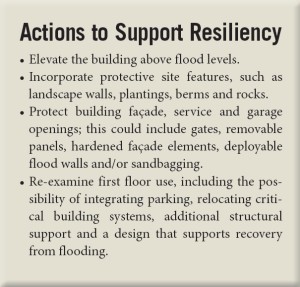
Mark Junghans
Changing climate conditions and extreme weather events are presenting new challenges for real estate and development professionals to design, permit and build projects that will endure the short- and long-term risks associated with the flooding that results from rising seas and super storms. Short of raising all sites above the flood elevation, what can property owners do to combat flood risks?
Addressing resiliency through design of new projects, or adaptive design of existing properties, is not a one-size-fits-all proposition. There are a variety of approaches and techniques that can provide protection against flooding. A new building and an existing building will likely take different paths to resiliency. An office building and a residential building may also require distinctive tacks.

Stephanie Kruel
The first step is to understand the project’s existing and future context and exposure, which varies widely based on location and elevation. Currently there are several publicly available resources for current and future flood information, including the Federal Emergency Management Agency (FEMA) website and town planning agencies. Flood zones are varied and diverse. In protected coastal areas such as much of Boston Harbor, flood elevations are generally static water elevations. Closer to the mouth of the harbor and in locations facing the ocean, flood elevations are higher due to wind and wave action. Flooding depth and duration vary by location. Flooding along river corridors may also be affected due to more intense or changing precipitation patterns.
The next step is to assess potential context-appropriate protection measures. Elevating buildings above the flood elevation, a viable option for new construction projects, is the most straightforward way to protect against flood impacts. Projects choosing this approach should also consider pedestrian and vehicular access to their site during and after a flood event, as well as impacts on electric, water and sewer systems.
Projects located in areas of wind and wave action, mostly those in less protected areas, even if above flood elevations, can include site features such as landscape walls, plantings, berms and rocks to dissipate storm energy and provide protection. This is a common approach that has been implemented in many locations in Boston and Cambridge. One notable example is the Spaulding Rehabilitation Hospital in Charlestown, which used a combination of landscape features and a raised site elevation to enhance protection.
Buildings with occupied floors exposed to flooding require different approaches to protection. Openings in building façades can be protected with gates or removable panels that allow the building face to resist encroaching water. Deployable flood walls have been implemented at the Atlantic Wharf site in Boston, allowing the owner to create a waterproof perimeter when needed and storing the panels when not in use.
 Some existing building owners are looking at their first floor uses differently. Parking on the first floor in a flood zone can be achieved on new projects. Existing buildings may also need to design other first floor uses to withstand and survive inundation. This approach, as any, should be assessed with an eye to the frequency of flooding and an understanding of potential costs and business disruption. Owners should consider locating critical building systems (electrical transformers and emergency generators) above the first floor. New construction located in a flood zone must also be “hardened” though additional structural support.
Some existing building owners are looking at their first floor uses differently. Parking on the first floor in a flood zone can be achieved on new projects. Existing buildings may also need to design other first floor uses to withstand and survive inundation. This approach, as any, should be assessed with an eye to the frequency of flooding and an understanding of potential costs and business disruption. Owners should consider locating critical building systems (electrical transformers and emergency generators) above the first floor. New construction located in a flood zone must also be “hardened” though additional structural support.
As extreme weather events become more commonplace, so too does the need for creative solutions to build and maintain resiliency. Property owners, real estate developers and industry consultants need to work closely with local planning agencies to determine the best steps to achieve resilient outcomes for their projects. Successful flood protection requires looking beyond standard solutions, developing innovative alternatives and promoting resiliency – now and in the future.
Mark S. Junghans is a principal and Stephanie Kruel is a senior environmental planner at VHB.




 |
| 